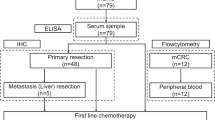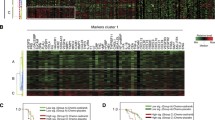Abstract
We have previously shown that the tumor necrosis factor family member a proliferation-inducing ligand (APRIL) enhances intestinal tumor growth in various preclinical tumor models. Here, we have investigated whether APRIL serum levels at time of surgery predict survival in a large cohort of colorectal cancer (CRC) patients. We measured circulating APRIL levels in a cohort of CRC patients (n=432) using a novel validated monoclonal APRIL antibody (hAPRIL.133) in an enzyme-linked immunosorbent assay (ELISA) setup. APRIL levels were correlated with clinicopathological features and outcome. Overall survival was examined with Kaplan–Meier survival analysis, and Cox proportional hazards ratios were calculated. We observed that circulating APRIL levels were normally distributed among CRC patients. High APRIL expression correlated significantly with poor outcome measures, such as higher stage at presentation and development of lymphatic and distant metastases. Within the group of rectal cancer patients, higher circulating APRIL levels at time of surgery were correlated with poor survival (log-rank analysis P-value 0.008). Univariate Cox regression analysis for overall survival in rectal cancer patients showed that patients with elevated circulating APRIL levels had an increased risk of poor outcome (hazard ratio (HR) 1.79; 95% confidence interval (CI) 1.16–2.76; P-value 0.009). Multivariate analysis in rectal cancer patients showed that APRIL as a prognostic factor was dependent on stage of disease (HR 1.25; 95% CI 0.79–1.99; P-value 0.340), which was related to the fact that stage IV rectal cancer patients had significantly higher levels of APRIL. Our results revealed that APRIL serum levels at time of surgery were associated with features of advanced disease and prognosis in rectal cancer patients, which strengthens the previously reported preclinical observation of increased APRIL levels correlating with disease progression.
Similar content being viewed by others
References
**a XZ, Treanor J, Senaldi G, Khare SD, Boone T, Kelley M et al. TACI is a TRAF-interacting receptor for TALL-1, a tumor necrosis factor family member involved in B cell regulation. J Exp Med 2000; 192: 137–143.
Dillon SR, Gross JA, Ansell SM, Novak AJ . An APRIL to remember: novel TNF ligands as therapeutic targets. Nat Rev Drug Discov 2006; 5: 235–246.
Ingold K, Zumsteg A, Tardivel A, Huard B, Steiner QG, Cachero TG et al. Identification of proteoglycans as the APRIL-specific binding partners. J Exp Med 2005; 201: 1375–1383.
Kimberley FC, van Bostelen L, Cameron K, Hardenberg G, Marquart JA, Hahne M et al. The proteoglycan (heparan sulfate proteoglycan) binding domain of APRIL serves as a platform for ligand multimerization and cross-linking. FASEB J 2009; 23: 1584–1595.
Lascano V, Zabalegui LF, Cameron K, Guadagnoli M, Jansen M, Burggraaf M et al. The TNF family member APRIL promotes colorectal tumorigenesis. Cell Death Differ 2012; 19: 1826–1835.
Rennert P, Schneider P, Cachero TG, Thompson J, Trabach L, Hertig S et al. A soluble form of B cell maturation antigen, a receptor for the tumor necrosis factor family member APRIL, inhibits tumor cell growth. J Exp Med 2000; 192: 1677–1684.
Hahne M, Kataoka T, Schröter M, Hofmann K, Irmler M, Bodmer JL et al. APRIL, a new ligand of the tumor necrosis factor family, stimulates tumor cell growth. J Exp Med 1998; 188: 1185–1190.
Moreaux J, Veyrune JL, De Vos J, Klein B . APRIL is overexpressed in cancer: link with tumor progression. BMC Cancer 2009; 9: 83.
Mhawech-Fauceglia P, Kaya G, Sauter G, McKee T, Donze O, Schwaller J et al. The source of APRIL up-regulation in human solid tumor lesions. J Leukoc Biol 2006; 80: 697–704.
Petty RD, Samuel LM, Murray GI, MacDonald G, O'Kelly T, Loudon M et al. APRIL is a novel clinical chemo-resistance biomarker in colorectal adenocarcinoma identified by gene expression. BMC Cancer 2009; 9: 434.
Ding W, Wang J, Wang F, Wang G, Wu Q, Ju S et al. Serum sAPRIL: a potential tumor-associated biomarker to colorectal cancer. Clin Biochem 2013; 46: 1590–1594.
Planelles L, Castillo-Gutiérrez S, Medema JP, Morales-Luque A, Merle-Béral H, Hahne M . APRIL but not BLyS serum levels are increased in chronic lymphocytic leukemia: prognostic relevance of APRIL for survival. Haematologica 2007; 92: 1284–1285.
Went P, Tzankov A, Schwaller J, Passweg J, Roosnek E, Huard B . Role of the tumor necrosis factor ligand APRIL in Hodgkin's lymphoma: a retrospective study including 107 cases. Exp Hematol 2008; 36: 533–534.
Novak AJ, Grote DM, Stenson M, Ziesmer SC, Witzig TE, Habermann TM et al. Expression of BLyS and its receptors in B-cell non-Hodgkin lymphoma: correlation with disease activity and patient outcome. Blood 2004; 104: 2247–2253.
Schwaller J, Schneider P, Mhawech-Fauceglia P, McKee T, Myit S, Matthes T et al. Neutrophil-derived APRIL concentrated in tumor lesions by proteoglycans correlates with human B-cell lymphoma aggressiveness. Blood 2007; 109: 331–338.
Yamauchi M, Morikawa T, Kuchiba A, Imamura Y, Qian ZR, Nishihara R et al. Assessment of colorectal cancer molecular features along bowel subsites challenges the conception of distinct dichotomy of proximal versus distal colorectum. Gut 2012; 61: 847–854.
Guo YW, Wei XQ, Li YW, Zheng FP, Yang SJ . [Effects of matrine, 5-fluorouracil and cisplatin on the expression of APRIL in hepatocellular carcinoma HepG2 cells]. Zhonghua Gan Zang Bing Za Zhi 2008; 16: 532–533.
Guadagnoli M, Kimberley FC, Phan U, Cameron K, Vink PM, Rodermond H et al. Development and characterization of APRIL antagonistic monoclonal antibodies for treatment of B-cell lymphomas. Blood 2011; 117: 6856–6865.
Steenbakkers PG, Hubers HA, Rijnders AW . Efficient generation of monoclonal antibodies from preselected antigen-specific B cells. Efficient immortalization of preselected B cells. Mol Biol Rep 1994; 19: 125–134.
Acknowledgements
We thank the statistics help desk from the AMC for expertize advice on the statistical methods employed in this study. Collection of clinical data and serum samples was supported by the popgen 2.0 network, funded by a grant from the German Ministry for Education and Research (01EY1103).
Author information
Authors and Affiliations
Corresponding author
Ethics declarations
Competing interests
The newly designed antibodies were developed by BioNovion B.N., Oss, The Netherlands. Patent number NL2011406.
Additional information
Supplementary Information accompanies this paper on the Oncogenesis website
Rights and permissions
Oncogenesis is an open-access journal published by Nature Publishing Group. This work is licensed under a Creative Commons Attribution-NonCommercial-NoDerivs 4.0 International License. The images or other third party material in this article are included in the article’s Creative Commons license, unless indicated otherwise in the credit line; if the material is not included under the Creative Commons license, users will need to obtain permission from the license holder to reproduce the material. To view a copy of this license, visit http://creativecommons.org/licenses/by-nc-nd/4.0/
About this article
Cite this article
Lascano, V., Hahne, M., Papon, L. et al. Circulating APRIL levels are correlated with advanced disease and prognosis in rectal cancer patients. Oncogenesis 4, e136 (2015). https://doi.org/10.1038/oncsis.2014.50
Received:
Revised:
Accepted:
Published:
Issue Date:
DOI: https://doi.org/10.1038/oncsis.2014.50
- Springer Nature Limited




